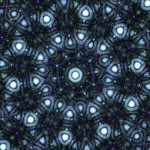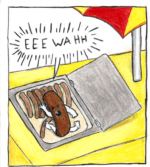Chicago’s Concertina Gallery
by Beth Capper and Ricardo Harris-Fuentes
 Katherine Pill is the kind of person that will blow her lunch money on the paintings of a hitherto unacknowledged artist, or live in an apartment without furniture so that she can create an exhibition space with a snappy name like the Concertina Gallery. She eats, works, and lives in art. As well as being the Administrative Director of SAIC’s SUGs Gallery, this summer Pill and two fellow students, Corinna Kirsch and Francesca Wilmott, conspired to open an apartment space named Concertina Gallery in which they could explore a more personalized curatorial practice. Concertina combines professional presentation and high quality work, while taking advantage of the more relaxed atmosphere of the apartment gallery. The result is an artist-oriented and curator-run space, with an emphasis on generating new scholarship about the art showcased.
Katherine Pill is the kind of person that will blow her lunch money on the paintings of a hitherto unacknowledged artist, or live in an apartment without furniture so that she can create an exhibition space with a snappy name like the Concertina Gallery. She eats, works, and lives in art. As well as being the Administrative Director of SAIC’s SUGs Gallery, this summer Pill and two fellow students, Corinna Kirsch and Francesca Wilmott, conspired to open an apartment space named Concertina Gallery in which they could explore a more personalized curatorial practice. Concertina combines professional presentation and high quality work, while taking advantage of the more relaxed atmosphere of the apartment gallery. The result is an artist-oriented and curator-run space, with an emphasis on generating new scholarship about the art showcased.
F Newsmagazine: I heard that you are pushing to exhibit bigger artists to combine with the smaller local artists you are exhibiting, and that this is a move to establish good relationships with commercial gallerists, and heighten the profile of apartment galleries.
Katherine Pill: First off, we should say that building relationships with commercial galleries is not a main goal of Concertina. We are interested in establishing all kinds of connections, and we are happy to work with different organizations in order to bring in the artists we want. Having said that, yes, we want to portray ourselves as a responsible space that can exhibit bigger-name artists. Working with commercial galleries, we have an opportunity to show artists we admire, and money never enters the equation. We get to contextualize their art in potentially new ways, and the artist and dealer get to reach a different demographic.
F what do you think about the idea that apartment galleries are an attempt to counter established ideas about professionalism?
 KP Certainly apartment galleries have the capacity to stand in opposition to the commercial art world, and for some that might be a main goal. The DIY component of apartment galleries is what makes them so exciting, I think, as usually the only person you need to answer to is your landlord. This freedom allows for some very creative things to happen, and for a more playful atmosphere. For us, however, challenging the commercial art world is just not our aim. We embrace the freedom to do whatever we want in our space. We really see it as our curatorial playground, and it gives us the opportunity to work with a variety of artists we admire.
KP Certainly apartment galleries have the capacity to stand in opposition to the commercial art world, and for some that might be a main goal. The DIY component of apartment galleries is what makes them so exciting, I think, as usually the only person you need to answer to is your landlord. This freedom allows for some very creative things to happen, and for a more playful atmosphere. For us, however, challenging the commercial art world is just not our aim. We embrace the freedom to do whatever we want in our space. We really see it as our curatorial playground, and it gives us the opportunity to work with a variety of artists we admire.
I don’t know about apartment galleries as a challenge to established ideas of professionalism. For us, I think we consider “professionalism” to be closely linked to respect. Respect for artworks should be a part of any exhibiting space. We don’t necessarily want to create a formal exhibition atmosphere, but we want to be respectful to the artists we show, and we hope that visitors similarly respect our home.
F What do you see as being the problems of apartment galleries? Do you find that they create insular, cliquey audiences? Is bringing in bigger artists a good way to bring more diverse publics?
KP Apartment galleries do have a reputation for being cliquey and only showing the works of friends. I’ve actually never really seen this as a major problem, as it’s a supportive gesture to exhibit the work of a friend and those exhibitions still have the potential to foster new relationships.
We do, however, strive to bring in diverse audiences. The School provides a strong, important audience, and looking around it seems that most apartment galleries in the city have strong ties to SAIC. As important and supportive as this audience is, we hope to maintain a diverse draw, and exhibiting artists from a variety of backgrounds really helps with that.
F Can you tell me a little about the upcoming “Australia” show. How did it come about? Why do you think someone should see it?
KP It was a pretty organic process. “Australia” came about during a late-night brainstorming session for our October exhibition. Francesca and I were discussing some recent studio visits we’d done, and we realized that two artists we were interested in had both used Baz Luhrmann’s movie as source material. The relationship was too interesting to pass over, so we began to discuss how looking at their different approaches to the movie allowed for a unique entry-point to each of their practices. For instance, we really liked the contrast between Anthea Behm’s stripping away of Hollywood illusion, and Aron Gent’s amplification of it. The exhibition is fairly challenging, as Behm’s work especially asks a lot from the viewer. We couldn’t be happier with how it turned out —both artists really engaged with the gallery space, and their work complements one another in really interesting ways. We are currently working on an essay that will be on our website that gives more detail to the concept, as the content is extremely loaded.
F What makes your curatorial vision unique?
KP We stress the fact that we are “curator-run”, which for us means an emphasis on written materials. We have an essay for each exhibition, and hope to solicit more as the year goes on. It’s also important to us to show artists at different points in their career, and from different parts of North America. Finally, the space itself is very unique, and we try to work with artists who are interested in engaging with its architectural details and history.
32”x 40”, 2009. Image courtesy of the artist.
Luke Painter, Woodlot House #2, 2008 India ink on archival paper, 45” x 69”. Image courtesy of the artist.





















